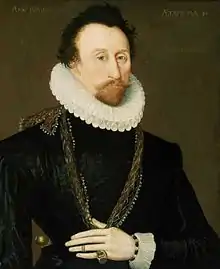Sea Dogs
The Sea Dogs were a group of sea-raiders and privateers who were authorized by Elizabeth I of England. They also engaged in slave trading.[1] They committed piracy in the Caribbean as well as in European waters.

Overview
The Sea Dogs were originally a military branch authorized by the Elizabeth I to attack the Spanish fleet to loot ships and bring back treasure. They carried "Letters of Marque",[2] which made their plundering of Spanish ships legal under English Law. The Sea Dogs were started in 1560 as a way to bridge the gap between the Spanish Navy and the English Navy. As England lacked a formal navy strong enough to defeat Spain, the Sea Dogs served as a way to attack Spanish ships during what was technically peacetime. The Sea Dogs continued carrying out raids against the Spanish until 1604, when England and Spain made peace. After that, many of the Sea Dogs continued as pirates employed by the Barbary States, in what would become the Anglo-Turkish piracy in the Caribbean.[3]
Notable Sea Dogs
Sir Francis Drake (1540–1596)
Sir Francis Drake was one of the most profitable and successful sea dogs of all time.[4] As captain of Golden Hind, he served in the English Navy from 1563–1596 and achieved the rank of Vice Admiral. Drake was trained early on in the maritime arts by Sir John Hawkins, his cousin and fellow slave trader. Drake also was the second man in history to circumnavigate the globe; which he accomplished while robbing Spanish ships. Drake had a huge range of coverage, raiding up the Spanish on the Pacific Coast all the way up to modern day San Francisco. In addition to his commandeering of ships, Drake would sail into ports in the Caribbean to put ransoms on cities, after which he would begin burning the city down until he received payment. Drake was awarded a knighthood in the year of 1581. He later died of dysentery after an unsuccessful attempt to take San Juan, Puerto Rico.
Sir John Hawkins (1532–1595)
Sir John Hawkins was born into a wealthy family where his father was a sea captain.[5] Hawkins initially sailed with his father on trading trips, but by 1562 he became “England’s first slave trader” using his fleet of three ships led by the "Jesus of Lübeck" to aggressively take 400 Africans from Guinea, Africa, and sell them in the West Indies. He traded in slaves for about five years, making three voyages to Sierra Leone and Guinea and selling 1,200–1,400 African slaves to the Spanish. Queen Elizabeth I gave him a Coat of arms which featured a bound slave.[6]
Sir Walter Raleigh (1552–1618)
Sir Walter Raleigh was another important Sea Dog.[7] A favorite of the queen, he received a title that allowed him to claim any land that he discovered in the name of England. During an expedition to the New World, he founded the colony of Roanoke which later vanished. Raleigh became infatuated with the idea of a "city of gold" hidden somewhere in South America and set out on an expedition to find it. On his second expedition to find "El Dorado", he ended up in a bit of a predicament after men under his subordinate Lawrence Keymis looted a Spanish Outpost. After this outrage, Raleigh went back to England. The Spanish, were displeased, as they were aware of what Raleigh's men did in violation of the extant peace treaties. As a compromise, Raleigh was executed in the reign of King James I Stuart (1566–1625).[8]
Sir Richard Hawkins (1562–1622)
Sea Dogs and the Spanish Armada
After years of picking off and looting by English Sea Dogs, Philip II of Spain decided that he had had enough. Philip II mobilized an armada of 130 ships to sail into the English Channel and decided to attempt to end English sea-raiding for good. The Spanish ships were bigger and more heavily armed, but the English ships were smaller, faster, and more maneuverable. Concurrently, a large storm came while the Spaniards were on their way causing them to suffer terrible losses. They ended up retreating after losing more than half of their original ships.[9]
References
- English/British naval history to 1815: a guide to the literature Eugene L. Rasor p. 247
- Elizabethan Sea Dogs 1560–1605 Angus Konstam, Angus McBride
- United States history to 1877 Nelson Klose, Robert F. Jones p. 17
- Elizabethan Sea Dogs 1560–1605 Angus Konstam, Angus McBride p. 3
- Elizabethan Sea Dogs 1560–1605 Angus Konstam, Angus McBride p. 3
- Sick economies: drama, mercantilism, and disease in Shakespeare's England Jonathan Gil Harris. pp. 152ff
- Elizabethan Sea Dogs 1560–1605 Angus Konstam, Angus McBride p. 3
- Mimesis and Empire: The New World, Islam, and European Identities Barbara Fuchs p. 121
- Pestana, Carla (2004). The English Atlantic in an Age of Revolution, 1640–1661. Cambridge, MA: Harvard University Press. p. 180. ISBN 978-0674024120.
- DUDLEY, W. G. (2013). ELIZABETH'S SEA DOGS. Military History, 30(4), 56–63
- Martin, C. (2002). Gun Ships and Sea Dogs. British Heritage, 23(4), 34.